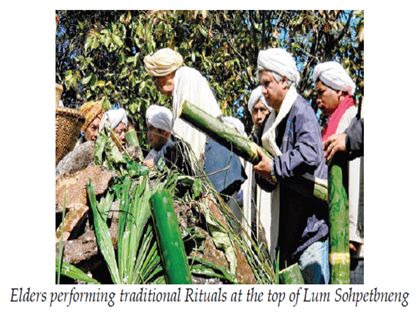
U Lum Sohpetbneng peak, nestle the Khasi civilization, ever since the Hynniewtrep Race, comprising the Khasi Pnar (Jaintia), the Lyngam, Maram, Bhoi, War, Nongtrai,, Muliang of the composite 'Khadhynriew Trep Khadhynriew Skum (Sixteen Huts- Sixteen Nests), dwell in the abode of the Divine Creator. It was the Hynniewtrep- the seven Huts the seven Nests, according to the Divine Decree, that the seven came down to settle on earth, through the Golden seven rainbow coloured bridge ( Jingkieng Ksiar)-(Golden Bridge) to become master of the animal and plant Kingdoms, the natural elements, that exist above Mother Earth (Ka Mei Ramew), the entire environment and ecology, the vast stretches of land and forests, mountains, hills, dales and valleys, oceans, rivers, streams, protecting all these from ravages.
 It is in every first Sunday, during the month of February, that a pilgrimage is held in the Lum Sohpetbneng Peak, 1434 meters above sea level, where homage and reverence is paid to the Divine Creator of the world and cosmos, and also sweet remembrance to the remaining Khyndai Trep Khyndai Skum (the Nine Huts and Nine Nests) who had remained in their celestial abode.
It is in every first Sunday, during the month of February, that a pilgrimage is held in the Lum Sohpetbneng Peak, 1434 meters above sea level, where homage and reverence is paid to the Divine Creator of the world and cosmos, and also sweet remembrance to the remaining Khyndai Trep Khyndai Skum (the Nine Huts and Nine Nests) who had remained in their celestial abode.
Twelve kilometres from capital Shillong on the Guwahati-Shillong national highway in the vicinity of the Umiam Tourist Complex, at the base of U Lum Sohpetbneng, stands the Heritage Gateway, reflecting the masonry art work of the ancients. The structural monument stands proud, as a major landmark, awe-inspiring, beneath stands the symbol of the cock or rooster in all its regalia.
U Lum Sohpetbneng Peak, meaning the peak of the umbilical navel cord, signifying the relationship between humankind and the divine above. The sacred and spiritual peak therefore expatiate, the various myths, that have turned into the legends, realities and history of the Khasi people, belonging to the Austric Mon Khmer speaking race, settled and tucked in Eastern Meghalaya from the Brahmaputra Valley in the north, down south to the Surma Valley bordering the plains of Bangladesh, who have survived of many historical invasions including Mir Jumla.
It is in the ridges and slopes of U Lum Sohpetbneng, inspired by folk narrative, that a systematic archaeological survey and exploration was conducted in the hill range, by Marco B and his team of the North Eastern Hills University, where different cultural periods were revealed, including the works of Sankardeva, Bhagavata Purana, and also records of the Ahom Kings of Asom, the Jayantiya Buranji, providing information of the Ahom Kings with the Hindu Kingdom of Jaintiapur, now in Bangladesh, which was conquered by the King of Hima Sutnga of Khasi Hills, later known as Hima Jaintia, derived from the name of princess Jayanti. Jaintia Hills was annexed to the British territory in March15, the year 1835.
Sumar Sing Sawian
To read the further article please get your copy of Eastern Panorama February issue @http://www.magzter.com/IN/Hill-Publications/Eastern-Panorama/News/ or mail to contact @easternpanorama.in


